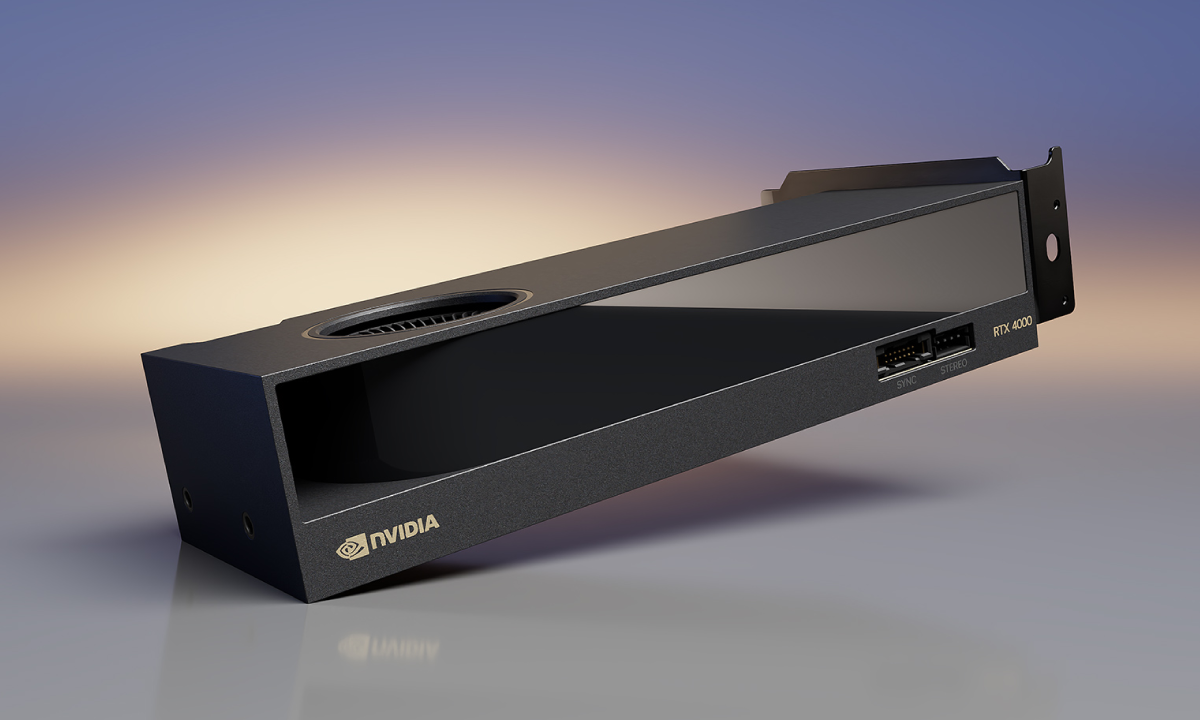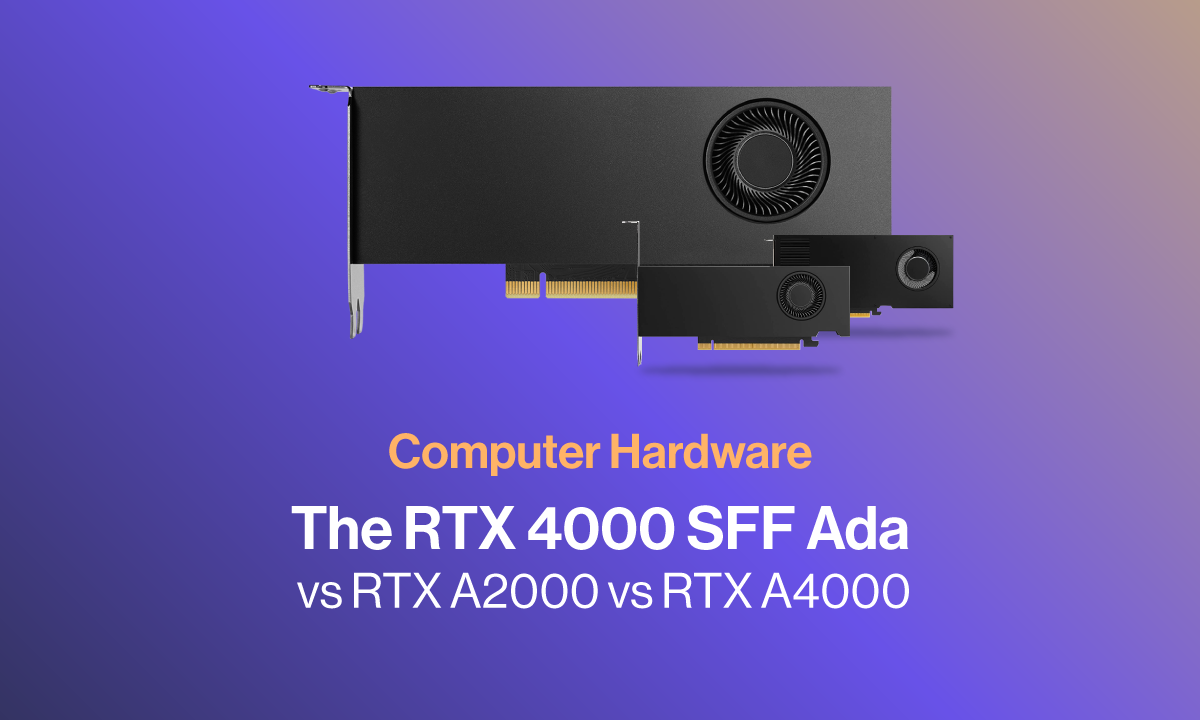The Tiny GPU That Could
NVIDIA released the RTX 4000 SFF Ada last month as their compact workstation GPU at a dual-slot half-length GPU to replace their last generation A2000 variant. The naming convention is very confusing as ever (but what do we expect from NVIDIA). In this blog we will go over the release and what we can expect from this tiny GPU, its capabilities, and how it stacks up with last-generation NVIDIA RTX GPUs.
NVIDIA RTX 4000 SFF Ada Specs
The RTX 4000 SFF Ada boasts 6144 CUDA cores, 192 Tensors, and 48 RT cores with 20GB GDDR6 ECC VRAM across a 160-bit interface with a memory clock at 16 Gbps. All of this runs on only 70W powered through the PCIe slot; zero power cables needed.
| RTX 4000 SFF Ada | |
|---|---|
| Memory | 20GB DDR6 ECC |
| Interface | 160-Bit |
| Bandwidth | 280 GB/s |
| CUDA Cores | 6144 - Ada |
| Tensor Cores | 192 - 4th Gen |
| RT Cores | 48 - 3rd Gen |
| Single Precision Perf. | 19.2 TFLOPS |
| RT Core Performance | 44.3 TFLOPS |
| Tensor Performance | 306.8 TFLOPS |
| Power Consumption | 70W |
The NVIDIA RTX A4000, which shared the naming with the recently released RTX 4000 SFF Ada, is a single-slot full-length GPU that housed 16 GB of memory. Whereas the NVIDIA RTX A2000 is a dual-slot half-length GPU with 12 GB of memory (the 6GB is EOL) that matches the form factor. Based on the lack of a power connector and the form factor (and the fact that NVIDIA themselves have the two GPUs on comparison graphs), we conclude the RTX 4000 SFF Ada is the successor to the RTX A2000.
RTX 4000 SFF Ada vs Other GPUs in its Class
By looking at Single Precision, the RTX 4000 SFF Ada has a performance comparable to the RTX A4000 from the last generation with half the power target (140W to 70W Total board power). This makes this tiny GPU perform extremely well versus last-generation NVIDIA Ampere generation GPUs. Let's dive a little deeper at the notable RTX GPUs from the last generation we can compare with.
| RTX 4000 SFF Ada | RTX A2000 | RTX A4000 | |
|---|---|---|---|
| Memory | 20GB DDR6 ECC | 12GB DDR6 ECC | 16GB DDR6 ECC |
| Interface | 160-Bit | 192-Bit | 256-Bit |
| Bandwidth | 280 GB/s | 288 GB/s | 448 GB/s |
| CUDA Cores | 6144 - Ada | 3328 - Ampere | 6144 - Ampere |
| Tensor Cores | 192 - 4th Gen | 104 - 3rd Gen | 192 - 3rd Gen |
| RT Cores | 48 - 3rd Gen | 26 - 2nd Gen | 48 - 2nd Gen |
| Single Precision Perf. | 19.2 TFLOPS | 8.0 TFLOPS | 19.2 TFLOPS |
| RT Core Performance | 44.3 TFLOPS | 15.6 TFLOPS | 37.4 TFLOPS |
| Tensor Performance | 306.8 TFLOPS | 63.9 TFLOPS | 153.4 TFLOPS |
| Encode Decode | 2x Encode, 2x Decode | 1x Encode, 1x Decode | 1x Encode, 1x Decode |
| Power Consumption | 70W | 70W | 140W |
Compared to the RTX A2000, the RTX 4000 SFF Ada is 2.5x faster in raw single-precision performance. At the same power target, the RTX A2000 is about 8 TFLOPs whereas the RTX 4000SFF is performing well above at almost 20 TFLOPs. With the massive 20GBs of memory on the RTX 4000 SFF Ada is a great upgrade for those looking for the best small form factor GPU in productivity workloads that view large scenes as well.
Looking further, we can also see why the RTX 4000 SFF Ada and the RTX A4000 share the same name. They both share the same amount of CUDA Cores, Tensor Cores, Ray Tracing Cores, and single precision performance. But that’s where the RTX 4000 SFF Ada flips the script.
The RTX 4000 SFF Ada is built on the Ada Lovelace architecture with next-generation architecture on a smaller die. The next-generation Tensor Cores and Ray Tracing cores increase performance drastically, enabling faster and more efficient Ray tracing and Tensor Core performance than an RTX A4000 while being packaged in a small RTX A2000 size enclosure (dual-slot, half-length) while sipping on 70W of power.
The increase and advancement in the Ray Tracing cores will lend to a better experience when working in ray-traced environments such as 3D design and rendering. It has a larger memory capacity to handle large environments well without hiccups.
As for Tensor Core performance, the addition of a transformer engine and the ability to execute on mixed precision and FP8 enables a faster AI training and inferencing performance on the RTX 4000 SFF Ada. This can lend well to those developing and deploying AI models in environments such as genomics and computer vision.
Furthermore, the increase in encoding and decoding engines propel the RTX 4000 SFF Ada to be a great GPU for multi-media workload like video production, post processing, uploading, exporting, and rendering.

Who the RTX 4000 SFF Ada is For
Small form factor GPUs have been a neglected market for the GPUs with triple slot form factors or bigger GPUs getting all the attention. Large GPUs mean larger systems, which can be an advantage for better performance but is not ideal for professionals with little desk space or the need to be portable or not draw huge amounts of power.
RTX 4000 SFF Ada draws very little power and in turn, generates very little heat while performing heavy workloads. These GPUs are great for small office workspaces that require ample GPU performance such as 3D content creation and Manufacturing/Product Design by leveraging the 20GB of memory. It also wouldn't need a high-wattage PSU and could still drive multi-display with its 4x Mini-DisplayPort 1.4a connectivity.
Small form-factor workstations are a plus for large-scale deployments of workstations while keeping the physical footprint small. These machines accelerate high-resolution image processors for CAD and MPD or molecular visualization in the lab in health care and scientific computing without taking up valuable desk space. The RTX 4000 SFF Ada GPU, coupled with other energy-efficient components, reduces media studios' and research teams' carbon footprint to combat the climbing energy costs.
If you’re an at-home user, this powerful small form factor GPU can help you achieve that aesthetic Mini ITX build and perform admirably in heavy productivity workloads like CAD, simulation, 3D Design, and video editing while still running your favorite triple-A title games without becoming a space heater.
Last Remarks
The RTX 4000 SFF Ada in the end is a replacement for those who value a small form factor. Judging by the name of the GPU to include “Small Form Factor” in its name, we would probably expect NVIDIA to release a variant of this GPU in a single-slot full-length card for a high degree of expansion and multi-GPU capabilities.
Many data centers that cram extremely large amounts of GPU computing in a single node server require the slim design of a single-slot card to incorporate multiple GPUs in slim server racks like 1U and 2U. However, having both a dual-slot half-length and a future single-slot full-length can enable a larger degree of flexibility when it comes to consolidating your compute.
The RTX 4000 SFF Ada is a huge leap from the last generation, offering the same performance as a card with double the power draw. Without the need for a PCIe power connector, the RTX 4000 SFF Ada is a no-brainer for a low-power workstation that still packs a punch.
Looking to propel your workflow while keeping your workstations efficient in size and power?
Contact SabrePC today and inquire about our Small Form Factor Workstations or the NVIDIA RTX 4000 Ada SFF!


